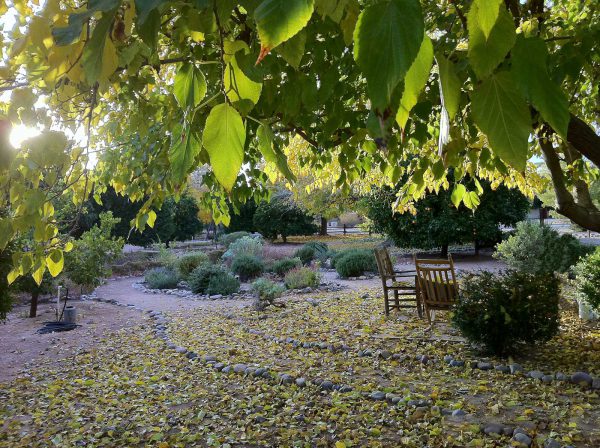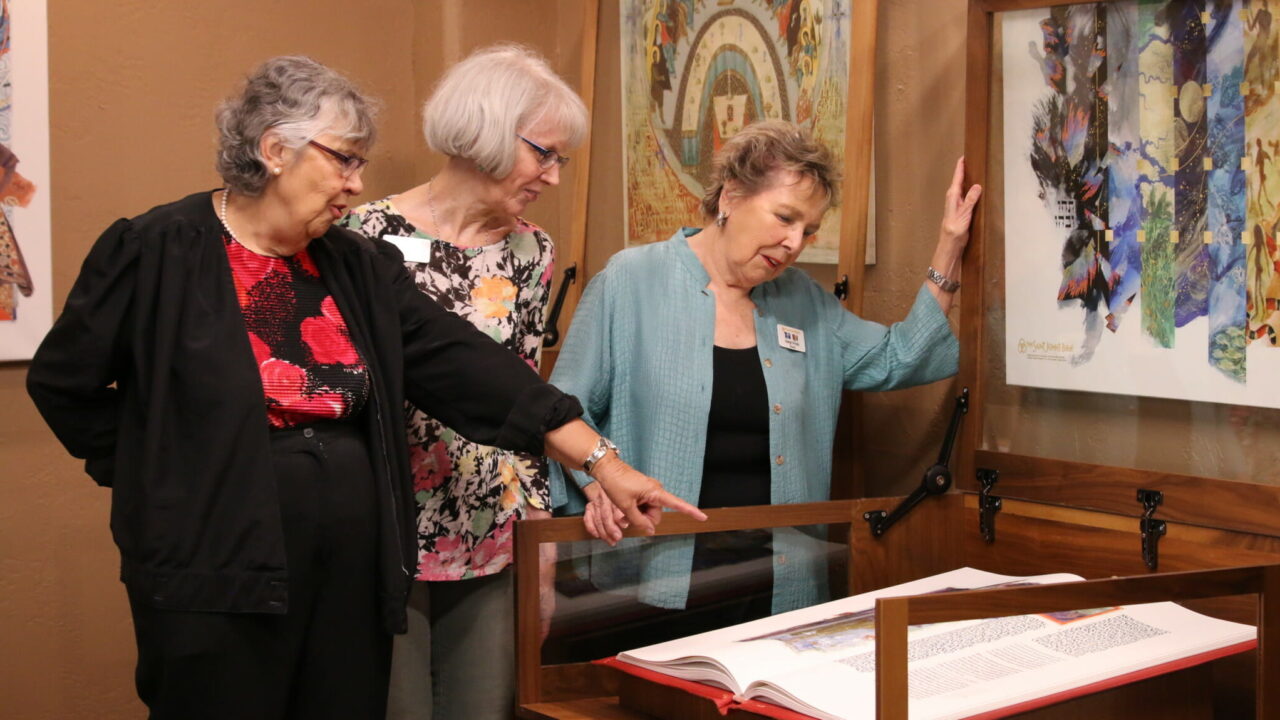Docents Nurture the Heritage Edition’s “Wow Factor” at Franciscan Renewal Center
A strong Phoenix art community lays the groundwork for appreciating the Heritage Edition
One of the best ways of understanding any work of art is having a knowledgeable teacher who can guide our thinking, ask challenging questions, and help us discover and articulate our personal responses. At the Franciscan Renewal Center in Scottsdale, Arizona, fondly called the Casa, this philosophy is applied not only to the church’s traditional teachings on scripture, but also to the art of The Saint John’s Bible, thanks to a unique docent program. Since the Casa’s acquisition of the Heritage Edition in 2014, 30-some volunteers in its community have undergone special training to help others make the most of their experiences viewing the Bible and other art on the campus.

The program is largely thanks to the efforts of Marge Woods, head docent for The Saint John’s Bible ministry at the Casa. Having served as a docent at the Phoenix Art Museum since the early 1970s, Woods was both deeply experienced in art education as well as informed on The Saint John’s Bible, following the exhibition of the original manuscripts at the museum in 2007 and 2008.
Looking back on that exhibition, Woods recalled that some speculated it may not be particularly popular. “They thought it’s not really a big churchgoing community,” she said. However, that sentiment changed after visitors saw The Saint John’s Bible up close. “It turned out to be one of our most highly attended exhibits,” Woods said. “It’s just a wow factor. People are always stunned by the beauty of the illuminations and calligraphy.”
The Casa’s Docent Team Takes Shape
When the Heritage Edition found a home at the Casa, “I got very enthused,” said Woods. She and several other docents from the museum quickly began developing a docent ministry at the Franciscan Renewal Center.
Theirs was no team of dilettantes—docents at the Phoenix Art Museum train for 18 months in art history, public speaking and research, and the museum’s program has been nationally recognized. With such a skilled group leading the way, the Casa’s docent program was soon off the ground. Today it covers not only The Saint John’s Bible, but also the architectural art glass in the Casa’s newly constructed Conventual Church of Our Lady of the Angels as well as other art pieces on the community’s 25-acre campus.
The docent team uses the Heritage Edition in the many presentations and retreats hosted at the Franciscan Renewal Center, and the volumes are also used in outdoor masses for Holy Week, which bring thousands of attendees to the Casa.
Reflecting on the Casa’s use of the Heritage Edition, Woods referred to a passage in Pope Francis’s “The Joy of the Gospel”:
Each particular Church should encourage the use of the arts in evangelization, building on the treasures of the past, but also drawing upon the wide variety of contemporary expressions so as to transmit the faith in a new ‘language of parables.’ We must be bold enough to discover new signs and new symbols, new flesh to embody and communicate the word, and different forms of beauty which are valued in different cultural settings, including those unconventional modes of beauty which may mean little to the evangelizers, yet prove particularly attractive to others.
“I think that hits the nail on the head as far as The Saint John’s Bible goes,” said Woods.
Prompting Personal Responses

With more than 40 years of experience in helping others appreciate art, Woods has finely honed her approach. “The way I like to tour,” she said, “is to give some of the facts, but it really is inspiring to have people look at the work—because everybody comes to the illuminations in a different way—and I’d really rather have them tell me what they’re responding to and how they’re responding. And somehow, as they get involved in it, it becomes much more their tour, rather than my tour.”
Having by now guided so many people in their first viewing of The Saint John’s Bible, Woods reflects, “The experience is always new. You just know that people are being touched in their own way and I think what I find most moving is that you have people who come in who really may not have been in touch with any religion, or maybe it was a long time ago. And somehow they’re being touched in a new way, and they’re being touched very personally.”
Guiding those personal connections is one of the great privileges of Woods’ work, and something that puts the entirety of her years as a docent in perspective. “It’s almost like my whole world turned around when I started at the museum in 1972 and it just led me in many different directions,” she said. “When I look back on it, I think The Saint John’s Bible is what I was being prepared for.”


